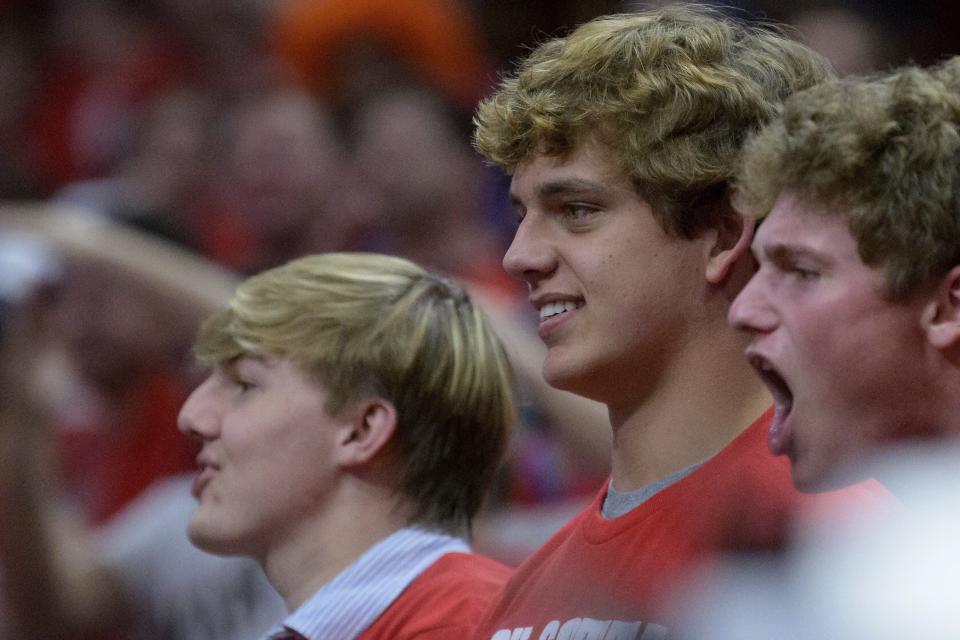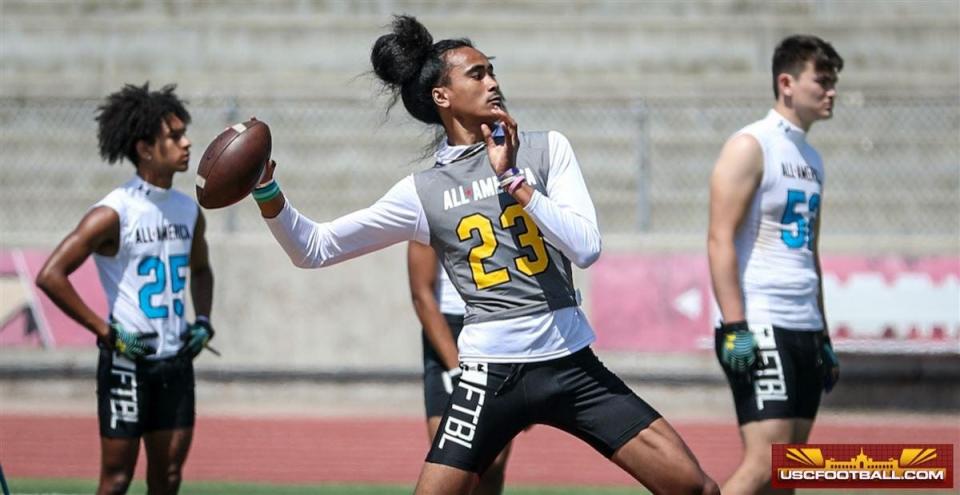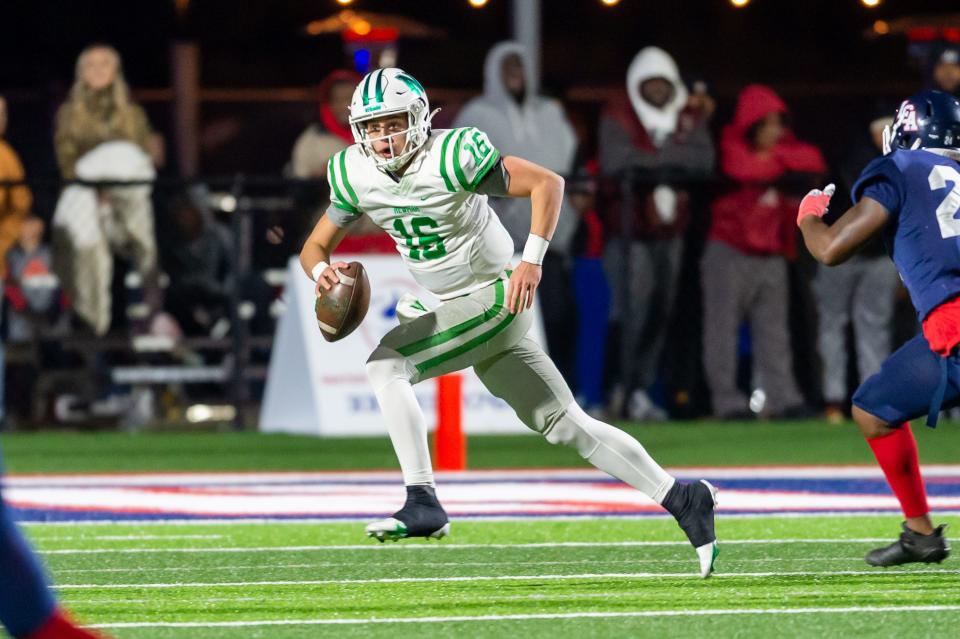Gene Frenette: Welcome to NIL reality, where colleges knew chaos was part of deal

Instead of standing for name, image and likeness, maybe the NIL acronym that has become a firestorm throughout college athletics should really be “numbers, inflation and lunacy.”
Craziness is already in motion and where it all stops, only lawyers, agents and family spokespersons for blue-chip high school recruits may know for sure.
If what we’ve seen in the past couple of months is the start of a wild, wild West atmosphere for recruiting, and which school collective might do the most NIL fundraising, it certainly looks like the potential for chaos has been unleashed.
Frankly, there should be a lot of positives emerging from NIL, designed to put more compensation in the pockets of college athletes through social media branding and a host of other relationship-connecting factors.
NIL — spawned by the combination of a litigation-fearing environment if student-athletes didn’t get a bigger piece of the pie and a unanimous Supreme Court ruling against the NCAA model to place limits on athletic benefits — has good intentions.
Gene's previous three columns:
Happy Mother's Day: Mom's calm after Hurricane Sandy kept NFL dream alive for Jaguars' Foley Fatukasi
Shared responsibility: Saturday sports menu: Khan deserves as much blame as Meyer, SEC dominance, NFL draft nugge
Piecing it together: Gene Frenette: Jaguars' rise to a winner starts with Doug Pederson bringing it all together
It’s no secret the antiquated NCAA model for amateurism needed a major overhaul. The organization couldn’t go on amassing billions of dollars in revenue and expect athletes who generate it receive only a scholarship and cost-above-attendance money, albeit those things still have significant value.
Change was overdue, and the nation’s highest court saw to it that would happen. Any attempt by the NCAA to retain status quo was resoundingly criticized by several Supreme Court justices, including this sharp needle applied by Brett Kavanaugh in his opinion, writing: “The NCAA’s business model would be flatly illegal in almost any other industry in America. It is not above the law.”
But anyone who spent any time in college athletics also knew the potential hazards that came with NIL, especially in recruiting. We’re already seeing eye-popping incentive numbers, which may or may not be completely accurate in the final account, but they certainly make college administrators take notice of what else is on the horizon.
An agent (Adam Papas) for Miami basketball player Isaiah Wong, who had declared for the NBA draft with the option of returning, recently threatened to ESPN to have his client transfer if he didn’t get a better NIL deal, already at a reported $100,000. Like maybe the $800,000 given to incoming Kansas State transfer Nijel Pack, another Papas client.
Later that same day, Wong, the second-leading scorer on an Elite Eight team, clarified that he wasn’t transferring and added Papas made his public comment without his authorization.
“Wong is an example of how things can really go wrong with NIL,” said retired Georgia athletic director Greg McGarity, now the Gator Bowl president. “It’s example A of how it should not work.”
![Florida Gators athletic director Scott Stricklin gestures during the introductory press conference at Exactech Arena in Gainesville, FL on Wednesday, March 23, 2022. [Matt Pendleton/Gainesville Sun]](https://s.yimg.com/ny/api/res/1.2/5EPcHhRzLr4zaTZKEMar0Q--/YXBwaWQ9aGlnaGxhbmRlcjt3PTk2MDtoPTY0MA--/https://media.zenfs.com/en/the-florida-times-union/52120fd33553db571b379b9a46e33ee2)
Stricklin: “This was totally predictable”
But with no firm parameters in place for how NIL is supposed to work, it was just a matter of time, at least once states began enacting NIL legislation last July, before cautionary tales like this surfaced.
It makes administrators wonder how many more instances of money grabs — NCAA rules still prohibit pay-for-play for athletes not enrolled in college — by recruits or their representatives might come to light as Power 5 football and basketball schools attempt to lure the best players into their programs.
“This is unprecedented because the courts have seen to it about the NCAA’s inability to set rules on benefits,” Florida athletic director Scott Stricklin told the Times-Union. “This was totally predictable.
“Every single person in college athletics understood this [testing of boundaries] was going to be the result of it, that schools and boosters would find a way to gain advantages in recruiting.”
In other words, college athletics is going to have to navigate its way through a murky NIL transition period for however long that might last. The NCAA, with a sit-on-his-hands president in Mark Emmert not being pro-active enough to prepare for the organization’s amateur model crumbling, will likely be nothing more than a spectator in this process.
With states around the country enacting different NIL legislation, and Congress reluctant to get involved in how to limit what is essentially becoming a free market enterprise, it could be up to the Power 5 conferences and the rest to find an adequate solution.
But it might not be a one-size-fits-all compromise. Let’s surmise, and this is purely speculative, conferences and school presidents decide to institute some type of NIL salary cap for their respective league.
If the SEC with its massive war chest and football passion decides to limit an athlete’s annual NIL income, say at $500,000, and other conferences decide that’s too rich for their blood, it’s not unrealistic to think a state legislature outside the SEC might seek to level the playing field. Or maybe some lawyer, who happens to be loyal to a certain SEC school, decides to challenge any NIL income salary cap as a way to further strengthen the league’s recruiting leverage.
There are so many variables to NIL, it’s impossible to know how things might shake out when all the initial turbulence settles down.

Some NIL numbers are staggering
The potential for NIL chaos is unimaginable at this point. After all, California 5-star quarterback Nico Iamaleava, the nation’s No. 4 overall recruit (Class of 2023) who is committed to Tennessee, has seen his On3 NIL valuation almost triple to $782,000 in three months.
What, you say, is an On3 NIL valuation? It’s an index that tries tries to set a market price for what the name, image and likeness of a high school and college-level athlete might be worth.
Rocky Top is already in a frenzy over Iamaleava, who has another year to build his brand on his Instagram, TikTok and Twitter accounts, so there’s no telling what financial benefits could be reached as Niko Mania explodes. He is rumored in one report to have a potential $8 million windfall by the end of his third year in college.
If that crazy number turns out to be accurate, that means Iamaleava would receive about equal to the total four-year contract for Alabama receiver John Metchie, the Houston Texans’ No. 44 overall pick in the NFL draft.
Which begs this question: what might be the NIL ceiling for New Orleans Isidore Newman High quarterback Arch Manning, the nation’s No. 1 recruit and arguably the most high-profile high school recruit of the 21st century?

No matter where Manning goes, and the frontrunners are reportedly Georgia and Texas, that school’s NIL collective may, figuratively speaking, have to load up a Brink’s truck for the nephew of Peyton and Eli Manning.
Maybe these gargantuan numbers for top recruits will be more hype than reality. But in this unprecedented landscape with no defined boundaries, there’s no telling what monetary amount deep-pocketed SEC football boosters might raise for their school’s NIL collective.
On Monday, the Division I Board of Directors — clearly in response to reports of alleged massive financial incentives for athletes yet to enroll in school — crafted a statement to try and discourage school boosters from using money in collectives as a way to provide inducements for high school recruits and transfers.
“There were no guard rails for this,” said McGarity. “College sports got exactly what they asked for with states reacting, and some overreacting. It was just chaos. I think you’re seeing a movement to get the paste back in the tube.”
It's an issue with so many variablesthat over the next couple years, who knows how many
Florida schools loading up
In Florida, where the state’s three most successful football programs have combined to win 11 national championships, Miami, Florida State and Florida are anxious to regain some of that past glory.
So it should come as no surprise the Big Three didn’t want to be left behind when it came to getting their NIL affairs in order.
Industry experts believe every Power 5 school will have some type of NIL collective in place this year. About half of those 65 programs currently have one or multiple collectives already set up.
Miami has a “Bring Back The U” collective founded by MMA team owner Dan Lambert and MMA fighter Jorge Masudal. The ‘Canes also have the backing of billionaire booster John Ruiz, who has signed over 100 UM athletes to NIL deals to promote his companies, LifeWallet and Cigarette Racing, according to the Miami Herald.
At FSU, athletes have the NIL option of Micconope 1851, along with another collective merger between Rising Spear and Warpath 850.
It’s obvious schools are trying to get an early jump on NIL for good reason: they don’t want to fall behind in recruiting or lose their own athletes by not being financially prepared to compensate them.
At Florida, the Gators are loading up with more just the high-profile Gator Collective, founded by former baseball player Eddie Rojas and his wife, Kelli. The Gators also have MarketPryceFlorida and Gator Guard, along with GatorsNILexchange, an avenue where athletes and businesses sign up to be in a portal to help them negotiate potential deals.
Stricklin minced no words about the Gators being monetarily ready to compete in the new NIL world, saying: “Where the University of Florida and the SEC is concerned, we’re very well positioned to make sure our student-athletes have the best experience and access to the most benefits as allowed by whatever rules are in place.”
It remains to be seen what those rules will eventually look like, but what is indisputable is the NCAA amateur model as many once knew it is being extinguished. Welcome to the NIL reality, where some privileged athletes may be getting a bigger slice of the money pie than many ever imagined.
“I’ve talked to some of my friends and it is a totally different world for ADs than it was during our time coming into the business,” McGarity said. “It’s hardly recognizable.”
Retired AD Dave Hart, who served at Florida State, Tennessee and Alabama, sees a topic with so many layers, it's hard to know what kind of chaos awaits.
"Boy, it's a quagmire out there," Hart said.
Say goodbye to free labor, and hello to a players’ arms race. The NIL price tag, across the country and especially in the SEC, will be almost as fascinating to watch as the games.
Gfrenette@jacksonville.com: (904) 359-4540
Gene Frenette Sports columnist at Florida Times-Union, follow him on Twitter @genefrenette
This article originally appeared on Florida Times-Union: The NIL reality: It may be too late for NCAA to get hold of monster

